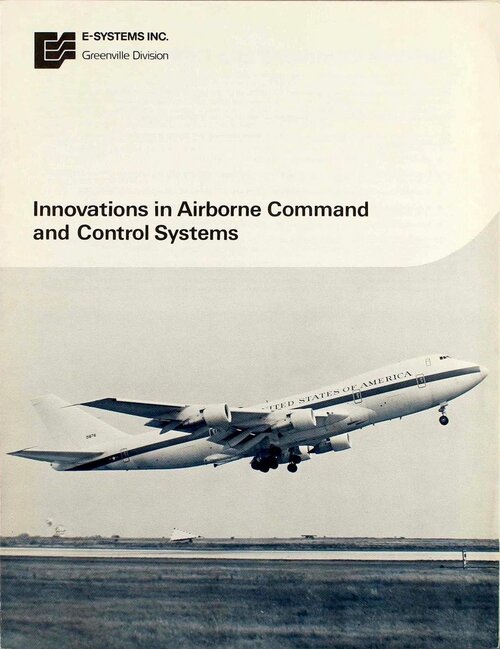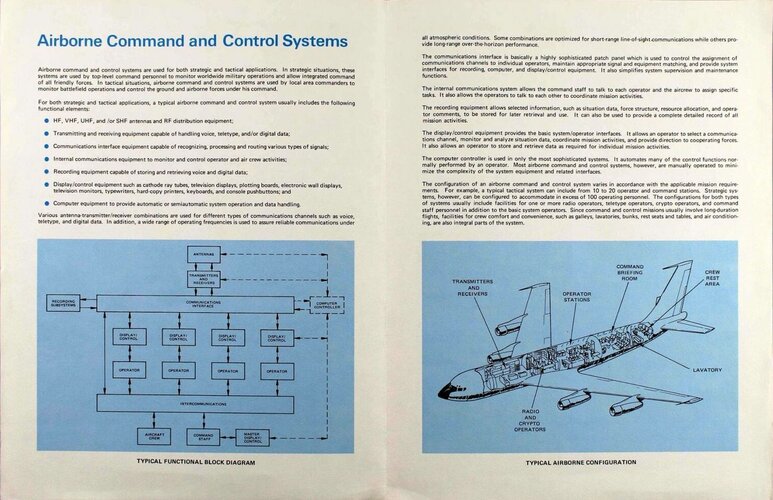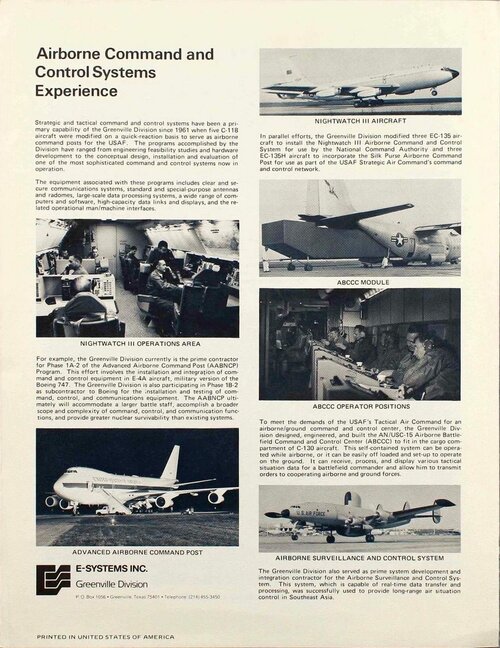From my files. I welcome any additions:
C 135
Boeing 717 Stratotanker/Stratofreighter
Specifications:
span: 130'10", 39.88 m
length: 134'6", 41.00 m
engines: 4 Pratt & Whitney J57 P 59W
max. speed: 532 mph, 856 km/h
The Boeing 717 evolved alongside the Boeing 707 from the Boeing 367 80. Instead of the double bubble fuselage of the 707 it had a circular fuselage.
The KC 135A was the first major production version and 724 were built against orders placed from 5 October 1954. The first flight took place on 31 August 1956. The length was 136'3" 41.53 m because of the refuelling boom. Although fitted as tanker aircraft they still had facilities to seat 80 troops. Some aircraft had J57 P 43WB engines. The serials were 55 3118/3146, 56 3591/3658, 57 1418/1514, 57 2589/2609, 58 001/130, 59 1443/1523, 60 313/355, 60 358/361, 60 363/368, 61 261/325, 62 3497/3580, 63 7976/8045, 63 8871/8888 and 64-14828/14840. Aircraft with serials 58 131/157 and 60 397/408 were cancelled.
The C 135A was a cargo/passenger version for 126 troops or 44 stretchers, or 54 casualty seats. 18 were built with serials 60 356/357, 60 362, 60 369/378 and 61 326/330.
The KC 135A and C 135A formed a pool of aircraft for many conversions. The designation EC 135A was used for a flying command post conversion and eleven were converted with serials 58 007, 58 011, 58 018, 58 019, 58 022, 61 262, 61 278, 61 287, 61 289, 61 293 and 61 297. At least one C 135A (55 3129) was used for tests as JC 135A whilst 14 KC 135As were flown as JKC 135A, including 55 3121, 55 3124, 55 3127, 55 3134/3136 and 56 3596. At least three C 135As (60 369/371) were used as NC 135A for permanent testing of optical an avionics equipment for the US Atomic Energy Commission for ionospheric measurements. They were fitted with many small windows and were also used to observes solar eclipses, comets etc. None of these aircraft were identical. A number of KC 135As were used as NKC 135A for permanent testing including research into high energy lasers, celestial navigation and NASA winglets. The serials included 55 3119, 55 3120, 55 3122/3125, 55 3127/3129, 55 3131, 55 3132, 55 3134, 55 3135, and 56 3596. Several C 135As and KC 135As were converted as VC 135A staff transports and included 55 3126, 57 2589, 60 378, 61 282, 61 310, 61 316 and 63 8020.
The RC 135A designation was assigned to a photo reconnaissance version known by Boeing as model 739. Four were built with serials 63 8058/8061 whilst 63 8062/8066 were cancelled.
The C 135B was a version fitted with Pratt & Whitney TF33 P 5 engines and 30 were built with serials 61 331/332, 61 2662/2674 and 62 4125/4139. In 1979 two aircraft with serials 61-4128 and 62-4133, were fitted with large radars and were used as EC 135B tracking aircraft. Two C 135Bs (61-2662 and 61 2669) were used for permanent tests in satellite communications as NC 135B whilst six C 135Bs with serials 61-2663, 62 4125/4127 and 62 4129/4130 were converted as VC 135B staff transports. Ten C 135Bs with serials 61 2665/2674 were converted as WC 135B weather reconnaissance aircraft. In 1993 three C 135Bs with serials 61-2670, 61 2672 and 61-2674, were converted as OC 135B for disarmament observation flights over Russia. The first flight was in May 1993. A WC-135B with serial 61-2667 was converted as a trainer with designation TC-135B before it was reverted back to WC-135B.
The KC 135B designation was used for a tanker version of the C 135B with a length of 136'3", 41.53 m. 17 were built with serials 62 3581/3585 and 63 8046/8057.
The RC 135B was a special electronics version and 10 were built with serials 63 9792 and 64 14841/14849.
The designation NKC-135B was used for conversions which took place in 1996 and included 63-8050.
The C 135C designation was assigned to three WC 135Bs which were converted as freighters. They had serials 61 2668, 61 2669 and 61 2671.
Eventually all KC 135Bs (62 3581/3585 and 63 8046/8057) were converted as EC 135C flying command posts although it is possible that by the time the conversion took place 3 aircraft had been scrapped. In addition aircraft with serials 64 14828/14832 were converted to this standard. The designation WC-135C was used for EC-135C 62-3582 which was converted for atmospheric and meteorological sampling.
Several RC 135Bs (64 14841/14849) were modified with different equipment and were redesignated as RC 135C whilst 63-9792 was also converted to this standard.
A single KC 135A (59 1491) and three C 135As (60 356, 60 357 and 60 362) were fitted with additional electronics as RC 135D but were later reconverted to their original status. The KC 135D was used for a conversion of four RC 135As with serials 63 8058/8061.
The RC 135E designation was assigned to a C 135B (62 4137) fitted with similar electronics as the RC 135D. It had an extended nose radome and a glassfibre antenna wrapped around the front fuselage.
Some C 135As and C 135Ns were converted to C 135Es in 1982 with Pratt & Whitney TF33 PW 102 engines. Serials were 60 372, 60 375 and 60 376. Of these 60 372 was further converted as NC 135E. Several EC 135Ns were fitted with TF33 PW 102 engines and were redesignated as EC 135E. The serials were 60 374, 61 326, 61-329 and 61-330.
The C 135F version was supplied to France. The twelve aircraft with serials 63 8470/8475 and 63 12735/12740 were fitted as tanker and 11 were later fitted with SNECMA CFM56 turbofans and redesignated C 135FR. They had serials 63 8470/8472, 63-8474/8475 and 63 12735/12740
Four KC 135As were converted as EC 135G airborne launch control centres for Minuteman missiles. The serials were 62 3570, 62 3579, 63 7994 and 63 8001.
Another five KC 135As were converted as EC 135H airborne command post. The serials of these aircraft were 61 274, 61 282, 61 285 and 61 291. A proposed conversion of aircraft with TF33 P 7 engines was designated as KC 135H but was not proceeded with.
The designation EC 135J was assigned to a single EC 135C and three KC 135As which were converted as airborne command posts for the Pacific area. The serials were 62 3584 and 63 8055/8057.
The EC 135K was yet another version of an airborne command post. The aircraft were converted KC 135As and the serials were 55 3118, 59 1518 and 62 3536. One of the aircraft was later used as the astronaut zero gravity trainer.
The EC 135L covered the conversion of KC 135As 61 261, 61 263, 61 269, 61 279, 61 281, 61 283 and 61 302.
Six VC 135Bs were converted as RC 135M electronic reconnaissance aircraft. They had an extended nose radome and a lobe central area fairing. The serials were 62 4131, 62 4132, 62 4134, 62 4135, 62 4138 and 62 4139. They were later converted as RC-135W.
Eleven C 135As were converted with large radar radomes as EC 135N ARIA satellite tracking aircraft. Some also had an ALOTS pod fitted. The serials were 60-372, 60 374, 60-375, 61 326/332 and 62-4128. Some were later converted as EC-135E. Aircraft 60-377 was converted as C-135N.
The designation EC 135P was assigned to the conversion of seven KC 135As with serials 55 3129, 58 007, 58 011, 58 018, 58 019 and 58 022 and 61-274. The designation KC 135P was used for a proposed conversion of tanker aircraft with TF33 P 7 engines. To meet the special refuelling needs of the Lockheed Blackbird 58 KC 135As were converted for this purpose as KC-135Q. The serials were 58 039, 58 042, 58 045/047, 58 049, 58 050, 58 054, 58 055, 58 060, 58 061, 58 062, 58-065, 58-069, 58 071, 58 072, 58 074, 58 077, 58 084, 58 086, 58 088, 58 089, 58 094, 58 095, 58 099, 58 103, 58 112, 58 117, 58 125, 58 129, 59 1460, 59 1462, 59 1464, 59 1467, 59 1468, 59 1470, 59 1471, 59 1474, 59 1480, 59 1490, 59 1504, 59 1510, 59 1512, 59 1513, 59 1520, 59 1523, 60 335, 60 336, 60-337, 60-338, 60 339, and 60 342/346.
The KC 135R designation was first used for a tanker/reconnaissance version of the EC 135A and were also referred to as RC 135R. The serials were 58 124, 58 126, 59 1514 and 61-320.
The RC 135S was assigned to a number of converted KC 135As and C 135Bs with serials 55 3133, 59 1491, 61-2662, 61 2663, 61 2664, 62-4128 and 63-9792. A training version was designated as TC 135S and at least one aircraft (62 4133) was converted.
A single JKC 135A (55 3121) was modified for electronic reconnaissance duties as RC 135T whilst a number of RC 135Cs (including 63-9792, 64 14847 and 64 14849) were converted as RC 135U.
The RC 135V designation was used for seven RC 135Cs and a single RC 135U which were updated with cheek radomes and an extended nose radome thereby combining the features of the RC 135N and the RC 135U. The serials were 63 9792, 64 14841/14846 and 64 14848.
The designation RC 135W was used for eight RC 135 ms which were converted like the RC-135V. The serials were 62-4125, 62-4130, 62-4130, 63 4131, 63 4132, 63 4134, 63 4135, 63 4138 and 63 4139. The TC-135W designation was assigned to aircraft 62-4129, whilst 61-2666 and 61-2667 were converted to WC-135W.
The three OC-135Bs with serials 61-2670, 61 2672 and 61-2674 were further converted as OC-135W. The NC-135W designation referred to a test aircraft with serial 61-2666 used to evaluate new equipment.
The EC 135Y designation was assigned to a single aircraft with serial 55 3125 which was converted. One aircraft, 64-4128, was converted as RC-135X.
It became eventually necessary to equip the aircraft with more efficient engines and this gave rise to a number of further designations, some of which out of sequence as, with the use of the RC-135X designation, no further letters were available.
The KC 135E designation has been used for the conversion of KC 135As with TF33 P 102 engines. Conversions included 55 3141, 55 3143, 55 3145, 55 3146, 56 3593, 56 3604, 56-3606, 56 3607, 56 3609, 56 3611, 56 3612, 56 3622, 56 3623, 56-3626, 56 3630, 56 3631, 56 3638, 56 3640, 56 3641, 56 3643, 56 3645, 56 3648, 56 3650, 56 3654, 56 3658, 57 1421/1423, 57 1425, 57 1426, 57 1428, 57 1429, 57 1431, 57 1433, 57 1434, 57 1436, 57 1438, 57 1441, 57 1443, 57 1445, 57 1447, 57 1448, 57 1450/1452, 57 1455, 57 1458/1460, 57 1463/1465, 57 1468, 57 1471, 57-1475, 57 1478/1482, 57 1484, 57 1485, 57 1491, 57 1492, 57 1494/1497, 57 1501, 57 1503/1505, 57 1507, 57 1509/1512, 57 2589, 57 2594, 57 2595, 57 2598, 57 2600/2604, 57 2606/2608, 58 003, 58 004/006, 58 008, 58 012/014, 58 017, 58 020, 58 024, 58 032, 58 037, 58 040, 58 041, 58 043, 58 044, 58 052, 58 053, 58 057, 58 058, 58 064, 58-067, 58 068, 58 078, 58 080, 58 082, 58 085, 58 087, 58 090, 58 096, 58 107, 58 108, 58 111, 58 115, 58 116, 59 1445, 59 1447, 59 1448, 59 1450/1452, 59 1456, 59 1457, 59 1473, 59 1477, 59 1479, 59 1484, 59-1483, 59-1485, 59 1487, 59 1489, 59 1493, 59 1496, 59 1497, 59 1499, 59 1503, 59 1505, 59 1506, 59 1509, 59 1514, 59 1516, 59 1519, 60-316, 60-327, 61-270, 61-271, 61-280, 61-281, 61-303, 62-3527 and 62-3566. Aircraft with serials 55 3129, 55 3132 and 55 3135 were converted as NKC 135E.
The KC 135R designation was used to designated aircraft converted with CFM F108 CF 100 engines. The first of these flew on 4 August 1982. They were also sometimes designated as KC 135RE. Serials included 56 3600, 56 3621, 56 3642, 57 1418, 57 1419, 57 1427, 57 1430, 57-1432, 57 1435, 57 1437, 57 1439, 57 1440, 57 1453, 57 1454, 57 1456, 57-1459, 57 1461, 57 1462, 57 1469, 57 1470, 57 1472/1474, 57-1479, 57 1483, 57 1486/1488, 57 1493, 57 1499, 57 1502, 57 1506, 57 1508, 57-1512, 57 1514, 57 2593, 57 2597/2599, 57 2605, 58 001, 58 004, 58 009/011, 58 015, 58 016, 58 018, 58 021, 58 023, 58 027, 58 030, 58 034, 58 035, 58 038, 58 051, 58 056, 58 059, 58 063, 58 073, 58 075, 58 076, 58 079, 58 083, 58 092, 58 093, 58 098, 58 100, 58 102, 58 104, 58 106, 58 109, 58 113, 58 114, 58 116, 58-118, 58 120/124, 58 126, 58 128, 58 130, 59 1444, 59 1446, 59 1453, 59 1455, 59 1458, 59 1459, 59 1461, 59 1463, 59 1465, 59 1466, 59 1469, 59 1472, 59 1475, 59 1476, 59 1478, 59 1482, 59 1483, 59 1488, 59 1492, 59 1495, 59 1498, 59 1502, 59 1507, 59 1511, 59 1515/1517, 59 1521, 60-313/315, 60-318/324, 60-326, 60-328, 60-329, 60-331/334, 60-336, 60-314, 60-347/351, 60-353, 60-358/360, 60-363/367, 61-264, 61-266, 61-267, 61-272, 61-275/277, 61-284, 61-288, 61-290, 61-292/265, 61-299, 61-300, 61-302, 61-304/318, 61-320, 61-321, 61-323, 61-324, 62-3498/3500, 62-3503/3521, 62-3523, 62-3524, 62-3526, 62-3530, 62-3531, 62-3533, 62-3534, 62-3537, 62-3538, 62-3540/3554, 62-3556/3559, 62-3561, 62-3565, 62-3568, 62-3569, 62-3571/3573, 62-3575/3578, 62-3580, 63-7976/7982, 63-7984, 63-7985, 63-7988, 63-7991/7993, 63-7995/7997, 63-7999, 63-8002/8004, 63-8006/8008, 63-8011, 63-8013, 63-8015, 63-8017, 63-8018, 63-8020/8033, 63-8035/8041, 63-8043, 63-8871/8876, 63-8880, 63-8883, 63-8884, 63-8886, 64-14828/14835 and 64-14840. It is expected that KC-135Rs will remain in service until 2032, when they will be 70 years old.
The KC-135T designations was assigned to 54 KC-135Qs converted with CFM F108-CF-100 engines. The serials were 58-045, 58-048/050, 58-052, 58-053, 58-057, 58-058, 58-063/065, 58-068, 58-072, 58-074, 58-075, 58-077, 58-080, 58-087, 58-089, 58-091, 58-092, 58-097, 58-098, 58-102, 58-106, 58-115, 58-120, 58-128, 59-1444, 59-1463, 59-1465, 59-1467, 59-1470, 59-1471, 59-1473, 59-1474, 59-1477, 59-1483, 59-1493, 59-1507, 59-1513, 59-1515, 59-1516, 59-1523, 60-315, 60-338, 60-339, 60-340, 60-342 and 60-345/349.
Other proposals included the KC 135ME with turbofans on the inner pylons and KC 135Y, the latter with modified wings.
The designations GNKC-135A, GNC-135A (60-369), GKC-135A (58-007), GKC-135E (56-3623 and 56-3645) and GKC-135H (61-282, 61-286) were used for ground instruction aircraft.
PS: sorry that some of the '-' have disappeared in copying, but I am sure you all know where they should have gone.




